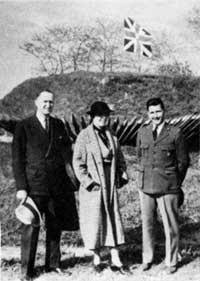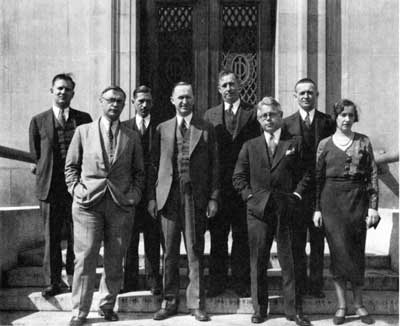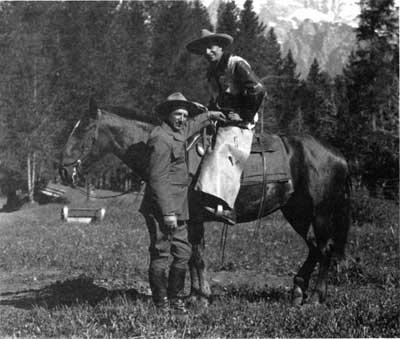MENU
|
National Park Service Uniforms Ironing Out the Wrinkles 1920-1932 |
Number 3 |
|
| |
 Horace M. Albright, his wife Grace and Superintendent William M. Robinson, Colonial National Monument, May 14, 1933. Robinson thought that khaki uniforms looked too much like the military and thought white would be more appropriate, leastwise for Colonial. NPSHPC - HMA Collection |
In January 1932 the uniform committee sent its formal recommendation for a summer uniform to the director. The committee thought that the existing style of uniform could be made out of khaki, with trousers in place of breeches. Included with the letter were two samples of the khaki material used by the Marine Corps for its uniforms and shirts. The Marine Corps quartermaster in Philadelphia had been contacted and was agreeable to making the uniforms needed by the Service, providing the problem of reimbursement could be worked out. The depot quartermaster stated that this would require legislation but thought it would be approved.
When the parks were informed, all but Superintendent William M. Robinson of Colonial National Monument agreed with the uniform committee. Robinson insisted that khaki uniforms looked too much like the military and thought that white uniforms were more appropriate. He felt that Colonial National Monument should have a distinctive uniform for its rangers in any event. Tomlinson wrote him in response:
"It is the Uniform Committee's understanding that it is the desire of the Director and of practically all of the field officers and park superintendents to keep the uniform standard throughout the entire National Park and National Monument Systems, rather than to authorize different uniforms for the various units. It is my opinion that the greatest value of the National Park Service Uniform is the fact that it is the same in Alaska, Hawaii, the Southwestern Monuments, Maine and all other national parks. The public is fast learning to recognize our uniform and we should I believe, encourage uniformity in every possible way." [31]
 Director Horace Marden Albright and his Washington staff, 1932. Albright was director of the National Park Service 1929-1933. Left to right: Conrad L. Wirth, asst. dir., Arno B. Cammerer, asst. dir., Ronald M. Holmes, chief clerk, Albright, Harold C. Bryant, asst. dir., Arthur E. Demaray, asst. dir. (operations), George A. Moskey, asst. dir., Isabelle Florence Story, editor NPSHPC - George A. Grant photo - HFC/WASO #17B |
Director Albright decided the matter on February 15, 1932, by approving Supplement No. 1 to Office Order No. 204. The new summer uniform was to consist of:
(a) Trousers, rather than breeches, of the style and cut now authorized for the standard uniform, of khaki material.
(b) Khaki blouse, of exactly the same style as the present woolen blouse.
(c) Shirt, gray flannel of light or medium weight with collar attached; or gray cotton with collar attached.
(d) Cap, of the same material as the uniform, to be of the English army officer type.
The summer uniform was to be worn complete, with no mixing of items with the other uniform. [32]
 Pete Bilkert, infamous highwayman in Jackson Hole, his hide-out. Picture made possible only by a chance meeting with photographer while outlaw was in a good humor. Samuel Tilden Woodring, superintendent, Grand Teton National Park, 1929-1934, and Peter E. Bilkert, Chief of the Statistical Division, NPS. Note the NPS on the horse and saddle blanket. NPSHPC - George A. Grant photo - GRTE/#140A |
In March 1932 the Service proposed to have the San Francisco office enter into a contract with a single supplier so that employees could secure uniforms of a standard color and quality at the lowest cost. Uniform orders would be placed by the parks, the Service would pay the supplier, and the costs would be deducted from the employees' pay. A deposit of at least 25% would be required from prospective employees. To facilitate getting the best possible price, all the parks were asked to send in their requirements for the upcoming season. The replies came in with all manner of remarks and uniform requests, one of which called for a "Ladies coat & skirt."
 Top
Top
Last Modified: Thurs, Dec 14 2000 9:30:00 pm PDT
http://www.cr.nps.gov/history/online_books/workman3/vol3c16.htm
![]()

